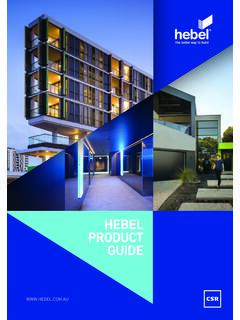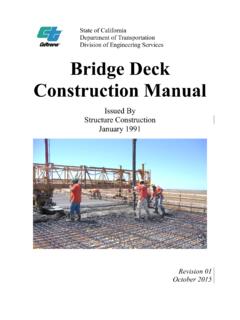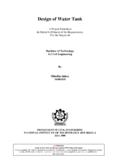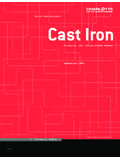Transcription of Technical Manual - Home - CSR Hebel
1 Technical ManualPart 4: Wall & Floor Panel Design & ConstructionCSR Hebel Technical Manual August 2010 7 Wall & Floor Panel Design & Construction Overview This section outlines the many factors to be considered when designing building solutions from CSR Hebel autoclaved aerated concrete (AAC) panels, and provides design tables and charts to assist the designer. The CSR Hebel panels can be group into four basic types relating to application, these types being: Floor panels; Wall panels; Ceiling panels; and Roof section has been broken into fourmajor areas as follows:Background Applications Design Information for CSR Hebel AACP anel Behaviour of a CSR Hebel Panel SystemsDesign of CSR Hebel AAC Panels Floor Panels Wall Panels Ceiling Panels Roof PanelsThis section includes; benefits, design andconstruction considerations, foundationsand movement joint requirements, designprocedures and design chartsOn-site Considerations On-site Handling InstallationConstruction Details Floor Panel Wall Panel Ceiling Panel Roof PanelWall & Floor Panel Design & ConstructionSection 77 CSR Hebel Technical Manual August 2010 7 Wall & Floor Panel Design & Construction Applications Applications CSR Hebel panels are reinforced, and are designed for floors, walls, ceilings and roof applications in multi-residential, commercial, residential (domestic) and industrial construction.
2 Multi-Residential Construction Non-loadbearing external wall panels,generally panels are fixed to a reinforcedconcrete structural frame. Internal wall panels party walls/ risers/shaft wallsCommercial Construction Non-loadbearing external wall panelsResidential (domestic) Construction External loadbearing wall panels, limited to2 storey construction, Roof panels Floor panelsIndustrial Construction Non-loadbearing wall panels, larger panelsspanning either vertically or horizontallycan be successfully incorporated intoindustrial wall applications. Mezzanine floors Ceiling panels fire exitsFigure : Rockdale Gardens, Rockdale, Sydney Figure : East Gardens Shopping Centre, NSW. Wall & Floor Panel Design & ConstructionSection 77 CSR Hebel Technical Manual August 2010 7 Wall & Floor Panel Design & Construction Design Information for CSR Hebel AAC Panel Codes and Regulations Design procedures for the verification of members and structures consisting of CSR Hebel autoclaved aerated concrete (AAC) panels generally follow the design principles outlined in Australian Standard AS3600-2009 Concrete Structures, with the exception of cover requirements for durability and development length for reinforcement.
3 The loadings on the panel products are to be determined in accordance with the Australia Standard AS1170 Design Actions series of codes. These codes cover typical loadings, such as dead load, live load, wind load, earthquake load, as well as others. Guarantee and Certification CSR Hebel is a business of CSR Building Products Limited ABN 55 008 631 356. It is a manufacturer and supplier of CSR Hebel Autoclaved Aerated Concrete (AAC) products. Because it is a manufacturer and supplier only, CSR Hebel does not employ people qualified as Accredited or Principal Certifiers. CSR Hebel is therefore unable to provide Construction Compliance Certificates or Statements of Compliance. CSR Building Products Limited does guarantee the products manufactured by itself and the products used in the systems described in CSR Hebel s literature, subject to the terms and conditions of the CSR Hebel Guarantee.
4 We do not however guarantee the components, products or services, such as installation and specialist advice, supplied by others. CSR Hebel conducts appropriate testing of its products and systems, and sources opinions to determine performance levels. These include structural, fire and acoustic. Testing and opinions are conducted and certified by appropriate specialists in these fields. CSR Hebel can provide copies of test results and opinions presenting the performance characteristics of its products and systems. When using CSR Hebel products and systems in specific projects, such specialists should be consulted to ensure compliance with the Building Code of Australia and relevant Australian Standards. CSR Hebel can provide a certification for its panel products.
5 For a specific project, an appropriate specialist can provide the certification of the relevant performance criteria of the systems and supporting structure. Foundations For residential application, the selection of the foundation type for use is similar to CSR Hebel blockwork and is based on AS2870, Residential Slabs and Footings . This standard covers the selection of footing designs for the usual range of site conditions, soil types and slopes. Where unusual site or load conditions are encountered, advice should be obtained from a practicing Structural Engineer. It is recommended that a practicing Structural Engineer is consulted concerning the application of AS2870 to any particular building construction or site. The approach to foundation design using AS2870 is to first classify the foundation soil, then assess the topography and select the appropriate footing design to be used.
6 Following is a guide to this foundation design approach. The structural engineer should approve this approach before adopting. Refer to Section 6 for further explanation of foundation design and & Floor Panel Design & ConstructionSection 77 CSR Hebel Technical Manual August 2010 7 Wall & Floor Panel Design & Construction For other applications of CSR Hebel panels, the foundation or supporting structure should be designed by the project structural engineer to satisfy the performance requirements of masonry (such as, deflection limits and stiffness). Cracking in Masonry As a result of the low tensile strength and negligible ductility, all forms of masonry construction behave as a brittle material and are therefore prone to cracking.
7 Similar to other forms of masonry, careful consideration at design stage and attention to detail during construction of autoclaved aerated concrete (AAC) masonry can minimise such adverse effects. It is important to note that the Building Code of Australia is performance based. The performance based approach acknowledges the possibility of cracking and does not consider it a defect so long as the structural resistance and other design requirements are maintained. Cracking of masonry building elements is often of little consequence, structurally or aesthetically, depending on the wall finishes. The Office of Fair Trading, Guide to Standards and Tolerances (April 1999) identifies cracking of more than 1mm a defect in rendered surfaces.
8 This limit is also specified in AS3700 and AS2870. Cracks up to 1mm, whilst not considered a defect in these documents, may allow water ingress in single skin masonry construction and therefore could be considered a defect under the BCA. This highlights the importance of good coating systems for CSR Hebel blockwork. Coating systems should be able to bridge minor cracking. Refer to BCA Part Weatherproofing for single skin masonry walls. Cracking can be due to external effects: Foundation and support movement. Deformation (shortening, shrinkage, creep,bridging control joints in structure, etc.) inadjacent materials. material properties of masonry unitsand their mortars must be taken intoconsideration when designing andspecifying masonry blockwork to preventor minimise cracking.
9 AAC differs slightlyfrom clay brick and concrete blockmasonry so in addition to the generalbehaviour of masonry, the effect of thefollowing differences must be considered: Lower compression capacity. Lower tensile strength. Lower modulus of rupture. Lower coefficients of thermal expansionand contraction and drying shrinkage. Larger unit size. Laid in thin bed mortar which typically hashigher compression capacity than theunits. Units are autoclaved. Dissipates and absorbs moisture from theatmosphere with associated for design and detailing: Elements of masonry blockwork must beisolated from movement. Control joints. Wall restraints. The compressive strength of rendercoatings must not exceed that of theblockwork. Use plasterboard linings internally. Use flexible coating systems that are ableto bridge hairline cracks.
10 Apply mesh within the render over areasof high & Floor Panel Design & ConstructionSection 77 CSR Hebel Technical Manual August 2010 7 Wall & Floor Panel Design & Construction Movement Joints ( ) During the life cycle of a building, the building and the materials that it is constructed from will move. These movements are due to many factors working together or individually, such as foundation movement (shrinkage and swelling), thermal expansion and contraction, differential movements between materials, climate and soil condition. This movement, unless relieved or accommodated for, will induce stress in the materials, which may be relieved in the form of cracking. To accommodate these movements and relieve any induced stresses, which could potentially crack the wall, movement joints (vertical gaps) shall be installed.













